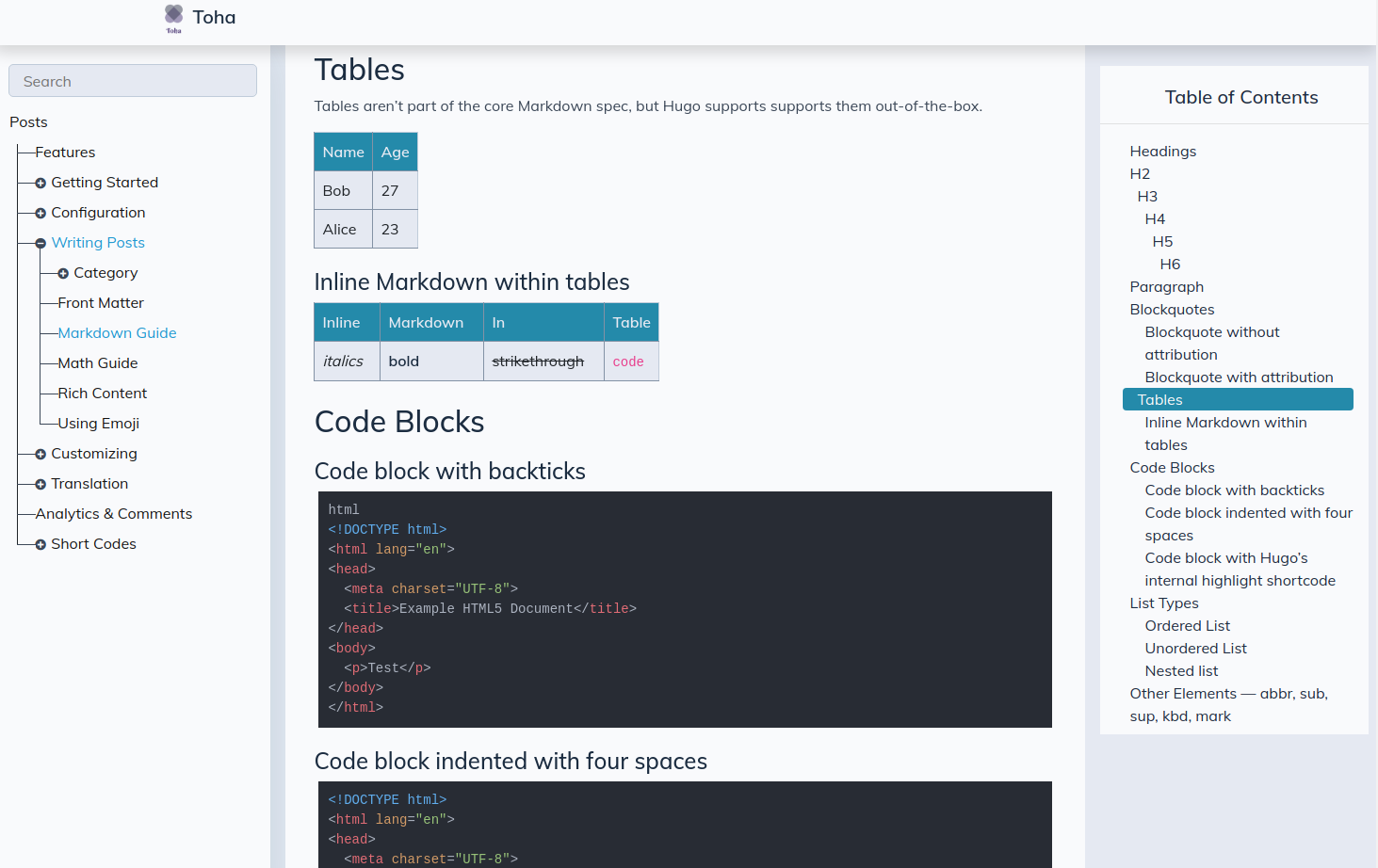A Hugo theme for a personal portfolio with minimalist design and responsiveness.
- Example Site: hugo-toha.github.io
- Documentation: toha-guides.netlify.app
- Minimalist Design
- Fully Responsive
- Multiple Language Support
- Carefully Designed Cards
- Experience Timeline
- Achievement Gallery
- Sidebar to Categorize the Posts
- Short Codes
- Analytics Support
- GoatCounter
- counter.dev
- Google Analytics
- Matomo/Piwik
- Comment Support
For more details about the features please visit here.
- English
- বাংলা
- Français
- Indonesian
- Deutsch
- Español
- 简体中文
- हिन्दी
- Italiano
- 日本語
- 한국어
- русский
- suomi
- Tiếng Việt
- Turkish
- Arabic (العربية)
- Português
- Català
- Português Brasileiro
To know more about how to translate your site, please visit here. Follow, the data and post format from this example site.
Here are few screenshots from the example site.
- Hugo Version 0.109.0 (extended) or higher
- Go language 1.18 or higher (require for hugo modules)
- Node version v18.x or later and npm 8.x or later.
The easiest way to use this theme is to fork hugo-toha.github.io sample repo.Then change the configurations according to your need.
If you want to start from scratch, then follow these steps:
At first, initialize Hugo modules in your repo. This will create a go.mod file.
hugo mod init github.com/<your username>/<your repo name>Now, in your config.yaml file, add a module section.
# Use Hugo modules to add theme
module:
imports:
- path: github.com/hugo-toha/toha/v4Check this sample config.yaml for further reference.
Now, run this command to load this theme as your module.
hugo mod tidyNow, you can run your hugo site locally with the following steps:
Now run the following command to generate node dependency configuration. This will create the a package.json file in you repo.
hugo mod npm packInstall the node dependencies using following command:
npm installNow, run you site locally using following command.
hugo server -wWhen you run your site for first time, it will start with the default parameters. It should look similar to the example site. However, it will not have any sections in the homepage as we haven't configured them yet. You can configure your site by following the guides from here.
Here, are some handy shortcodes you can use with this theme.
You can contribute to this theme in various ways. You can report a bug, file an feature request, send a PR, share your thoughts etc.
Pull requests are most welcome and I will be happy to review. Just follow the following principles:
- Keep it simple.
- Keep it consistent with the design.
- Use as few dependencies as possible.
- Have patience.
I am not a web developer. I have created this theme for my personal needs. So, it is reasonable to have some flaws in the codes. Feel free to open issues and PRs acknowledging the problems.
For local development, you can make changes in the theme submodule and test the changes against your own site or this example site locally.
At first, fork this repo. Then, follow the following steps to use the forked theme for local developments,
Using the forked theme in your own site:
If you want to run your local development against your own site, follow the following steps:
# add the original theme as a submodule of your site if you haven't done already
$ git submodule add https://github.com/hugo-toha/toha.git themes/toha
# navigate into the toha theme folder
$ cd themes/toha
# add your own fork as a remote
$ git remote add my-fork https://github.com/<your-github-user>/toha
# create a new branch for your changes
$ git checkout -b my-feature-branchUsing the forked theme in the example site:
If your want to run your local development against this example site, follow the following steps:
# clone the example site along with the submodules
$ git clone [email protected]:hugo-toha/hugo-toha.github.io.git --recursive
# navigate into the toha theme folder
$ cd themes/toha
# add your own fork as a remote
$ git remote add my-fork https://github.com/<your-github-user>/toha
# create a new branch for your changes
$ git checkout -b my-feature-branchFrom there you can make changes to the source code of the theme while testing with your running Hugo site or the example site.
When the changes look good, commit and push them to your fork.
# stage all the changes
$ git add .
# commit the changes with a meaning full commit message
$ git commit -m "A meaningful commit message"
# push the commit to your fork
$ git push my-fork my-feature-branchThen, open a PR against main branch of hugo-toha/toha from the my-feature-branch branch of your own fork.














